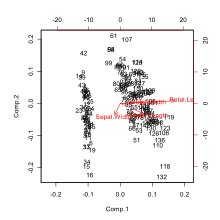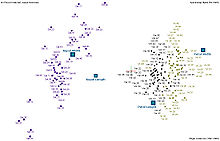Biplot



Biplots are a type of exploratory graph used in statistics, a generalization of the simple two-variable scatterplot. A biplot overlays a score plot with a loading plot. A biplot allows information on both
data matrix to be displayed graphically. Samples are displayed as points while variables are displayed either as vectors, linear axes
or nonlinear trajectories. In the case of categorical variables, category level points may be used to represent the levels of a categorical variable. A generalised biplot displays information on both continuous and categorical variables.
Introduction and history
This section may require cleanup to meet Wikipedia's quality standards. The specific problem is: Hard to follow, mostly contains the table of contents of 2 different books. (November 2020) |
The biplot was introduced by
discriminant analysis (DA) and various forms of correspondence analysis: simple correspondence analysis (CA), multiple correspondence analysis (MCA) and canonical correspondence analysis (CCA) (Greenacre 2016[5]
). The book by Gower, Lubbe and le Roux (2011) aims to popularize biplots as a useful and reliable method for the visualization of multivariate data when researchers want to consider, for example, principal component analysis (PCA), canonical variates analysis (CVA) or various types of correspondence analysis.
Construction
A biplot is constructed by using the
scalar product
interpretation. The first scatterplot is formed from the points (d1αu1i, d2αu2i), for i = 1,...,n. The second plot is formed from the points (d11−αv1j, d21−αv2j), for j = 1,...,p. This is the biplot formed by the dominant two terms of the SVD, which can then be represented in a two-dimensional display. Typical choices of α are 1 (to give a distance interpretation to the row display) and 0 (to give a distance interpretation to the column display), and in some rare cases α=1/2 to obtain a symmetrically scaled biplot (which gives no distance interpretation to the rows or the columns, but only the scalar product interpretation). The set of points depicting the variables can be drawn as arrows from the origin to reinforce the idea that they represent biplot axes onto which the samples can be projected to approximate the original data.
References
- ^ 'Gabriel, K. R. (1971). The biplot graphic display of matrices with application to principal component analysis. Biometrika, 58(3), 453–467.
- ^ Greenacre, M. (2010). Biplots in Practice. BBVA Foundation, Bilbao, Spain. Available for free at http://www.multivariatestatistics.org
- .
- ISBN 978-0-470-85153-1
- ISBN 978-84-923846-8-6
Sources
- .
- Gower, J.C., Lubbe, S. and le Roux, N. (2010). Understanding Biplots. ISBN 978-0-470-01255-0
- Gower, J.C. and Hand, D.J (1996). Biplots. ISBN 0-412-71630-5
- Yan, W. and Kang, M.S. (2003). GGE Biplot Analysis. ISBN 0-8493-1338-4
- Demey, J.R., Vicente-Villardón, J.L., Galindo-Villardón, M.P. and Zambrano, A.Y. (2008). Identifying molecular markers associated with classification of genotypes by External Logistic Biplots. Bioinformatics. 24(24):2832–2838
